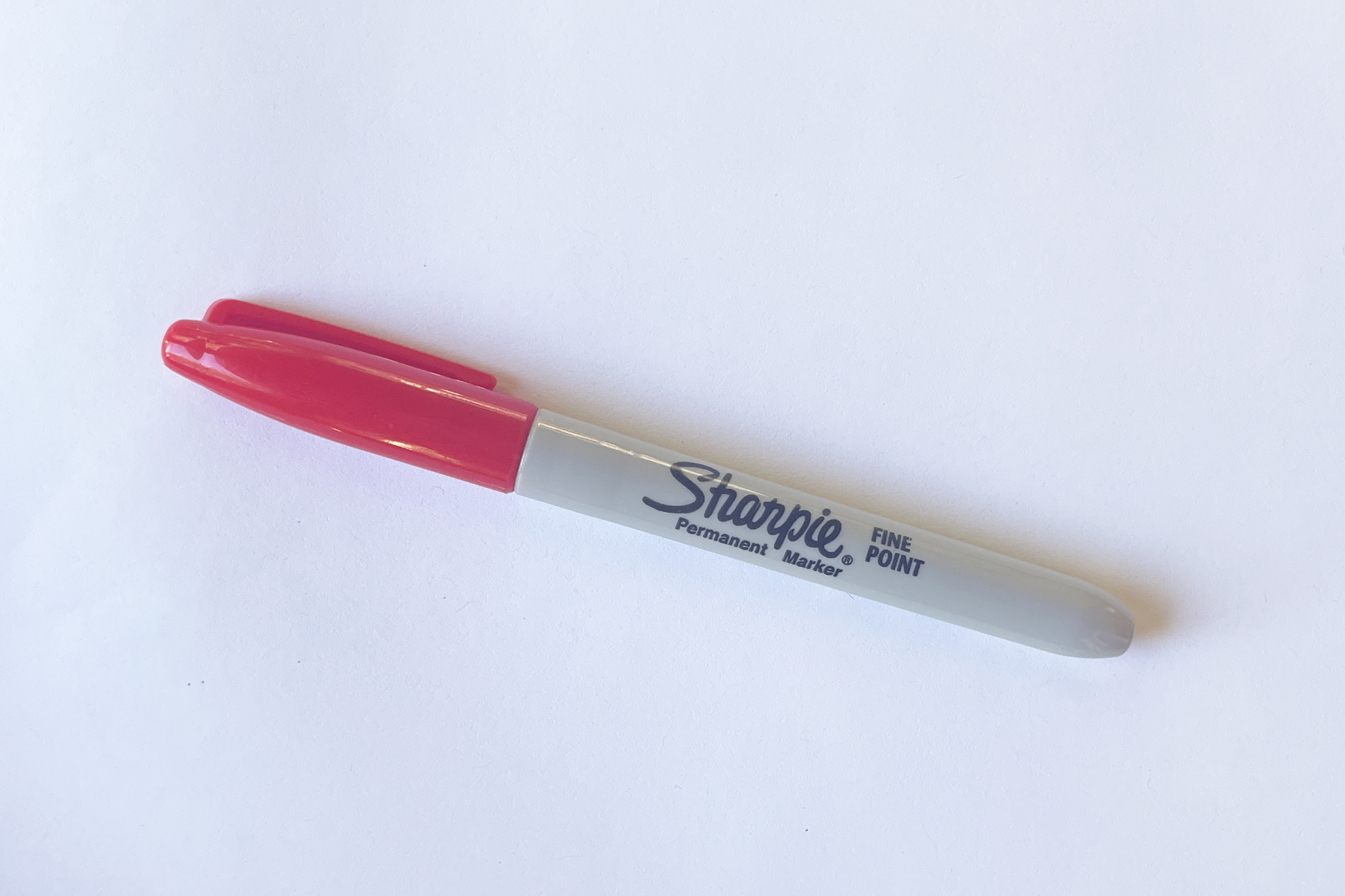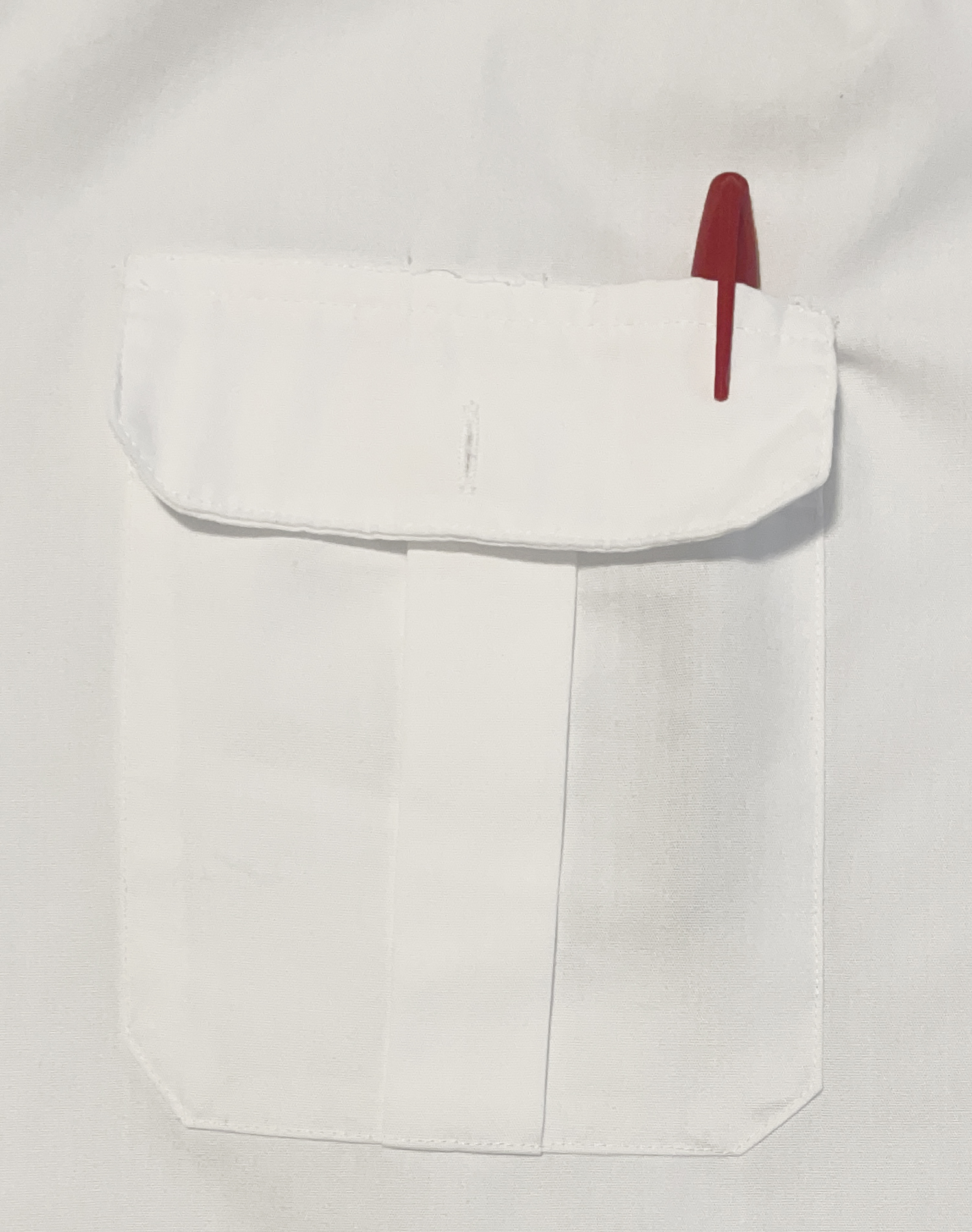Me and My Sharpie

October 24, 2022
LOTS GOING ON in the aviation world, beginning with the fact that I’ve retired my yellow highlighter. That’s right, I no longer carry a yellow highlighter as part of my pocket-flap ensemble of necessary cockpit gear.
Some months ago, you might recall, I talked about how, in the pocket of my (wrinkled) polyester pilot shirt, you’ll always find three things: a ballpoint pen, a highlighter, and a red Sharpie. The highlighter I’d use for marking up the flight plan. I’d go through it page by page, striking the important parts in yellow: the flight time, the alternates, the dispatcher’s desk number, the airport elevations, deferred maintenance items, ETP coordinates, etc.
Well, now that our flight plans have gone digital, there’s not much call for this. We still carry a hard copy version of the flight plan, it’s true, but at this point it’s just a backup, rolled and stuffed into a cubby hole near the center pedestal. And you can’t use a highlighter, really, on an iPad.
What I’m not letting go of, on the other hand, is my beloved red Sharpie.
The Sharpie is my tool for what we’ll call high-emphasis tasks, the most critical of which is putting my initials on the cap of my water bottle, to keep other pilots from drinking from it (there are sometimes four of us up there). I also use it for my scratch-pad notes. When I’m in the first officer’s seat on the 767, there’s a clipboard along the bottom ledge of the window, just to my right. I keep a folded piece of paper there on which I jot down various quick-reference info — a distillation of bullet points from the flight plan.
I prepare the sheet prior to departure, while still at the gate, as part of my preflight prep. The photo below is an example of a sheet used on a flight from Europe to the U.S. Here’s what it all means…

A. This is the flight number.
B. Planned flying time, wheels up to wheels down.
C. Arrival and departure times. Scheduled times are in red, in both local and UTC (Greenwich time). In this case, we’re scheduled to depart at 1110 local, and arrive at 1430 local. Or 1210 and 2030 respectively, in UTC. The addendum in pen, added after departure, is our arrival time based on when we actually took off. Today we’ll be 25 minutes early.
D. Fuel figures, in thousands of pounds. Block (B), minimum (M), and landing (L). Block fuel is our amount at pushback, which today will be 105,700 pounds. Minimum fuel is the lowest amount with which we’re permitted to commence the takeoff roll, in accordance with a slew of rules that we’ll save for another time. Landing fuel is our anticipated total at touchdown.
E. “300” is our initial expected flight level (altitude). That is, 30,000 feet, or “flight level three-hundred.” Below it I’ve written the name of the entry fix of our anticipated oceanic track, as well as our intended crossing altitude and speed. “LIMRI” is the fix name, and we hope to cross the Atlantic at 35,000 feet and Mach .79. This info will be added into the template of our oceanic clearance request.
F. We have 211 souls on board. That’s everyone: passengers, crew, and all the whiny kids riding in laps. The number below is the “assumed temperature” engine de-rate value used for takeoff (another topic for later). I’ll enter this into a datalink template later on; maintenance uses it to track engine performance.

G. This is the title of our assigned departure procedure (a series of initial routings, speeds and altitudes). We are cleared to depart via the “BELKO 6A.” I write it down because European departure controllers, on check-in after takeoff, often ask you to verbally verify which procedure you’re flying. Although you’ve got it loaded and have verified all the fixes and restrictions, the names can be confusing and easy to forget.
H. “T/A 50” means a transition altitude of 5,000 feet. This is the point at which our altimeters must be set to the standard pressure value of 29.92. This altitude varies country to country. “NADP” is a reminder that this airport requires us to fly a special noise-abatement departure procedure, with slightly different parameters for flap retraction and the setting of climb thrust.
I. Phonetic letter code (Foxtrot) for the most recent departure ATIS (Google it if you must), which I’ll pass along to ATC when necessary.
J. This empty section is where the arrival notes will go, later on. Items here might be the transition level for the destination airport, our gate number, and any anything else I might need to remember in a pinch. You might see radio frequencies here. For example, when flying into Los Angeles, controllers will often shift you from the north complex to the south complex, or vice-versa, on short notice, causing a flurry of arrival, approach, and taxi revisions. To stay a step ahead, I’ll write down all of the communications frequencies for tower, ground control and apron, in sequence, for both north and south sides. This info is on our charts, obviously, but it’s easier to have it on my cheat-sheet, ready to go, and not have to hunt around on my tablet while ATC is yelling at us.
Full disclosure: none of this is typical. Most pilots don’t bother writing much down aside from the flight number and maybe the departure fuel. But I’m a touch OCD, and, I don’t know, I’m just more comfortable this way. And it saves me from having to scroll through my iPad.
I suppose a regular pen would work just as well, but I like it all in red.
Related Story:





Leave a Comment
Maximum 1500 characters. Watch your spelling and grammar. Poorly written posts will be deleted!
35 Responses to “Me and My Sharpie”
You are viewing newest comments first. Click to reverse order
I’m learning to fly (apologies to Foo Fighters). One of the first things my instructor taught me is even though we all fly with IPads now, you absolutely 100% do not get into a cockpit without an actual writing instrument and a small pad of paper or notebook
“What I’m not letting go of, on the other hand, is my beloved red Sharpie.”
Looks like super-whack superstition or fetishism, which, of course, the pilots deny at their health screenings. I mean, dogs at the county animal shelter get more challenging scrutiny. Concerning …
Great article, Cap’n!
I enjoyed this so much, I’ve written a spinoff of your take for my blog. It’ll post this Monday, and will link to your article here. Thanks for a great post!
Eric “Cap’n Aux” Auxier ;o)
I should also say, lifelong aviation buff but not a pilot. Doctors who try to fly airplanes have a horrible safety record. I’m happy to leave that to the professionals. Love your blog Patrick. Avid reader since you were on Salon.
I’m an emergency medicine physician, and am constantly struck by the parallels between your profession and mine. We both have jobs which are grossly misrepresented and glamorized in popular culture, but which in reality are largely dictated by data-driven protocols. No one in my business ever uses the word “STAT” because it’s become such a TV cliché. I’m OCD as well, and have a blue sheet of paper on each patient, divided into sections for current and past history, pertinent physical exam findings, lab/imaging orders, and a blank section for any other relevant information. Not every ER doc does this, but I like things organized. In recent years medicine has been implementing checklists, following commercial aviation because of your incredible safety record, and our abysmal one. I said that once to a patient who was an airline pilot. His response was “that’s because you have bad airplanes!”
I’m trying to understand the times in “C”, if you are flying from Europe shouldn’t the local time be one hour ahead of Greenwich time? So 11:10 in Rome, say, would be 10:10 in Greenwich? Sorry, I’m probably missing something …
I love these detailed descriptions too!
As always Patrick, interesting insight! I appreciate your detailed explanation of your unique system.
Thank You!
While not a pilot, I’m just geeky enough to have LOVED this post!
About the “writing it down” part: “studies have shown” that handwriting engages the brain in a different way than typing does, for starters. (A few teachers, myself included, disallowed keyboarding for taking lecture or reading notes, unless an IEP required a keyboard.)
Handwriting to note ideas and “factoids” on paper is especially useful as it produces a “mind map” of information in a way that can’t be done from a keyboard. You know instantly where on the page to find what you need in the moment.
Someone here commented about looking at someone else’s horizontal scheme for notes and finding it odd, as he organizes “vertically.”
I was in an Airbus jumpseat once and noticed the FO had only one piece of paper in front of him. It was a post-it note with the names of the flight attendants. That was it.
This is great stuff, fascinating. My first thought was, “This should be standardized!” but then I realized that if it were, then there would be unending discussions of what to include, what to exclude, and quickly there would be more required items added and it would become useless.
See https://xkcd.com/927/ !
I got it, loud and clear. “Salient points” we used to call ’em. I got through law school like this with a yellow highlighter and the textbook. Lucky for me, because I can’t read my own handwriting!
extremely interesting ! you guys are flying for those like me, who never will !
certainly NOT the kind of ‘work’ one DREADS going to upon rising ! (WHENEVER !)
Take a look at what happens if you try to read your red sharpie with a red light at night. You might want to carry a blue one, too.
I’ve never been in a commercial cockpit at night. In GA and the military we had red lights for illumination. How visible are the red notes at night?
From student pilot days to present airline days (5 months to retire), 42 years worth and change, I have never been without a piece of paper with “stuff” on it attached to the yoke, a clip next to the window, or on a clipboard. And, thinking back over the years whether it be commuter, cargo, or the three majors, no matter which seat, ALL the pilots had a crib sheet. (Usually hotel stationary!)
Note: unless you were REALLY OCD and brought you cheat sheet out to the curb with you for pickup, how many ALWAYS remember the flight number when the van driver asks which flight you are? You may have just come off a coast to coast repeating your call sign a hundred times, but step off the airplane, that call sign got flushed!!
“…but step off the airplane, that call sign got flushed!”
Haha. It’s amazing how frequently this happens. Out on the curb, the van driver asks, “What was your flight number,” and suddenly we’re staring at each other. “Um…two…no, wait, three…?” This after repeating it dozens of times to ATC.
excellent read sir! I’d hope to have you as the pilot on my flights.
You may be surprised by how many pilot duplicate your effort. Most aircraft types have a clip somewhere at the pilot station to be used many things (holding the chip bag doesn’t count) including items such as this.
Personally the number one item (though not necessarily the most important) is the flight number. It is referred to constantly. The other information you include is almost a duplicate of mine though on ETOPS flights I usually add the go/return times and the alternates (senior years require mental prodding).
On the downside, I seem to attract “sharpie pocket stains”. Now that I am retired, there are a few remnants of my career hanging in my closet, some of them displaying distinctive red and black track marks, a reminder that preparation and information are a critical part of safe aviation.
Back in the day working as Captain when there were only paper charts I would organize all the airport arrival and departure plates for the various airports for the day in a folder that would fit next to the clipboard on the L-2 window. That kept all the information in reach without having to dig into the Jep charts.
I would also walk up to the gate agents desk to get the weight and balance sheet and do my own calculation for the takeoff weight and number of gallons of fuel uplifted. It was a quick way to check the agents math that at times would be incorrect by thousands of pounds.
OCD, I can be accused of that, but it helped to prevent errors before they turned to problems. It’s just a way of being a head of the plane, than to be digging out of hole by surprise.
As one of the SOB’s: technology is typically a blessing. When it works. My life is in someone else’s hands, especially when it doesn’t. Quickly and accurately knowing those details the time “ALL H*LL breaks loose” could mean I can continue to accrue frequent flyer points! Thanks for being up front and thanks for using the red sharpie!
As one of the SOB’s: technology is typically a blessing. When it works. My life is in someone else’s hands, especially when it doesn’t. Quickly and accurately knowing those details the time “ALL H*LL breaks loose could mean I can continue to accrue frequent flyer points!
I really appreciate the view into your cockpit workload and cheat sheet. Nicely worded explanations. Thanks!
I hope other 1st officers take note and do the same. I’d feel safer knowing you were in the right seat
Looks like a lot of unnecessary busy work.
No, not really. What’s “unnecessary busy work” is fumbling through your iPad to find the scheduled arrival time, or the minimum fuel, or the name of the SID, when instead you can have it jotted down in front of you.
Thanks for sharing that – enjoyed hearing about how you organize your notes. I always did something similar during my days as a USAF Navigator. Granted, iPads didn’t exist yet, but organizing notes like this always helped me to “stay ahead of the airplane”. It was often said that at 500+ kts, if you ever got “behind the airplane”, it was really difficult to recover and catch back up!
Hope the other pro’s and us general types got what staying “sharp” looks like; thank you.
Your share, “NADP” is a reminder that this airport requires us to fly a special noise-abatement departure procedure, with slightly different parameters for flap retraction and the setting of climb thrust” ——-is important and I would like to know how the “procedure” data was delivered or located for your use. Here’s why. Arrivals here at HPN (westchester county airport, NY) the
published NAAP for RWY 16 is active and quite specific.
Can you please tell me how, when and by whom arrival data is delivered.
Because most and I say 90% of the arrivals are not aware of, nor have used their sharpie for the arrival end of their plan Thanks to Flight Aware my scanner and my eyes and ears under the 16 approach I can confirm the low altitude along with the unnecessary gear, flaps and thrust parameters of the noise.
Is this real data, flight number 62? My understanding is that flights from east to west are odd numbers. In checking some of my flight records this has always been the case.
I have to admit, when I saw that there was 211 SOBs aboard, I thought it was a commentary on increasingly belligerent passengers… derp
You’re showing your age Patrick. Using pen and paper and not touchscreen. I presume the young pilots use their phone and tablet to do what you are here.
It has nothing to do with young or old. Like I said in the piece, most pilots don’t bother doing it at all. And my notes aren’t IN PLACE of anything digital; they’re just a quick rundown of the bullet points, to save from hunting and scrolling.
I do something similar, including writing down several radio frequencies I know I’ll need. Of course, I could just get them off my iPad. But I feel that going through the motion during preflight primes my short term memory.
What’s funny is that every pilot has some form of this shorthand. And if you hand it to another pilot, they probably won’t be able to make heads or tails of it. Example: I looked at my flying partner’s sheet the other day and saw he wrote everything horizontally. I’m a vertical guy – who knew?
The bit about priming your short term memory is also one of the reasons I do it. Writing it down is a form of emphasis.
Thanks for sharing this. It gives a lot of insight into the various information pilots have to keep track of.